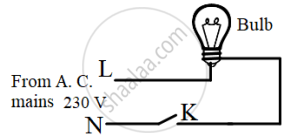Advertisements
Advertisements
Question
Explain the heating effect of electric current.
Solution
- When an electric current passes through a wire, the electrical energy is converted to heat.
- In heating appliances, the heating element is made up of materials with high melting point. An example of such a material is nichrome (an alloy of nickel, iron and chromium).
- The heating effect of electric current has many practical applications.
- The electric bulb, geyser, iron box, immersible water heater are based on this effect.
- These appliances have heating coils of high resistance.
- Generation of heat due to electric current is known as the heating effect of electricity.
APPEARS IN
RELATED QUESTIONS
Why does the connecting cord of an electric heater not glow hot while the heating element does?
What is meant by the heating effect of current? Give two applications of the heating effect of current.
Write scientific reason.
A coil made up of alloy Nichrome is used in the electric heater cooker as a resistor.
When does overloading occur?
(a) Observe the diagram given below and state whether the bulb will glow or not when we switch on K.

(b) Is it safe to handle the bulb when the switch is OFF?
(c) Give a reason for your answer in (b).
Fuse is a strip of alloy wire which is made up of lead and tin with a very low ______.
Name a few appliances which work on the basis of the heating effect of current.
A student boils water in an electric kettle for 20 minutes. Using the same mains supply he wants to reduce the boiling time of water. To do so should he increase or decrease the length of the heating element? Justify your answer.
1 kWh is equal to ______.
An electric kettle of 2 kW is used for 2h. Calculate the energy consumed in
- kilowatt hour and
- joules.
